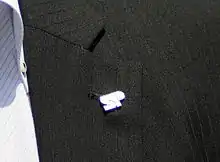Security Police (Japan)
The VIP Protection Division is a close protection unit of the Tokyo Metropolitan Police Department (TMPD).[1] The division is responsible for protecting domestic and foreign VIPs on Japanese soil and abroad and is part of the Security Bureau (警備部).[1][4]
| VIP Protection Division[1] | |
|---|---|
| Active | 13 September 1975 - present[2] |
| Country | Japan |
| Agency | Tokyo Metropolitan Police Department |
| Type | Close personal protection |
| Part of | Security Bureau[3] |
| Headquarters | Tokyo |
| Common name | Security Police (SP)[1] |
The division's officers are commonly known as Security Police (SP) (セキュリティポリス, Sekyuritī Porisu).[1][5] The officers wear SP insignia on their suit lapel, red neckties, and pocket handkerchiefs on their suits.[4][6] The word "SP" is a loanword that is used in the Japanese law enforcement system, based on the lapel pin seen on an officer's collar on his or her dress suit jacket.[3]
Prior to the divison's creation, riot police were used to conduct VIP protection duties.[7]

The division does not protect the Imperial Family which has its own dedicated division the Imperial Protection Division.[1] While the unit does protect the Japanese prime minister, he or she is protected by the Prime Minister's Official Residence Guard if they're inside the Kantei.
History
After an assassination attempt against the then-US Ambassador to Japan Edwin O. Reischauer was foiled by police in Akasaka, Minato, Tokyo in 1964, the chairman of the National Public Safety Commission decided to resign.[3]
It was not until June 18, 1975 when then-Prime Minister Takeo Miki was attacked publicly by Great Japan Patriotic Party secretary general Hiroyoshi Fudeyasu[8] that the National Police Agency announced that they were looking into ways of ensuring the safety of VIPs from the government[8] despite the presence of several police officers nearby.[2]
On September 13, 1975 the TMPD ordered the creation of the division.[2]
Duties
The division is mandated to provide close protection duties for the following people:[3][9][10]
- Prime Minister of Japan, former and current
- Ministers of State
- President of the House of Councillors
- Speaker of the House of Representatives
- Governor of Tokyo
- Foreign VIPs such as heads of states, ambassadors, etc.
- Other VIPs are designated by the head of the Public Security Bureau
Organization
The division is structured in the following way:
- Director
- Department Chief
- General Clerk
Section 1 is mandated to protect the Prime Minister of Japan. Section 2 protects the Ministers of State, Speaker of the House of Councillors and the President of the House of Representatives. Section 3 is known to conduct duties on guarding foreign VIPs such as ambassadors and heads of state while Section 4 are to protect the Governor of Tokyo and Other qualified VIPs who requested protection from the police(such as ex-Japanese Prime Ministers who became a members of the House of Representatives, Vice President of the House of Councillors, Vice Speaker of the House of Representatives, top members of the Political Party, etc).
Requirements

Candidates are trained in the police academy the same as ordinary police officers, they are taught by former SP officers and trained for a month. They must serve in the police for five years with the rank of Sergeant in order to be qualified.[3] Moreover, candidates are required to be more than 5 feet 8 inches tall (173 cm) (for male candidates), achieve at least a third dan in at least one martial art, and have a high level of marksmanship.[3]
Both male and female police officers can qualify for joining the division.[4]
Items
Officers are mostly armed with handguns and expandable batons during their duties. A mini flashlight and a transceiver is also in their list of equipment. Sometimes they used unmarked cars for transport and escort. They have used Mercedes-Benz S600, Toyota Crown, Nissan Teana, Nissan Elgrand,and Toyota HiAce.
The officers carry mostly the NPA-issued Smith & Wesson Model 37 revolver, or the SIG P230 semi-automatic pistol. Officers can also be seen armed with pistols such as the Beretta 92,[11] Glock 17 or Heckler & Koch P2000.[12]
Notes
- ^ Each of these sections are led by a Section Chief.
References
- "Securing Toyko and its citizens" (PDF). Tokyo Metropolitan Police Department. 2016. p. 25. Archived from the original (PDF) on 17 November 2017.
- "警視庁がSP隊設立【1975(昭和50)年9月13日】" [Metropolitan Police Department establishes SP]. Toushiru (in Japanese). Rakuten Securities. 13 September 2019. Retrieved 5 February 2021.
- "What is the Security Police?". Japan Security Management Academy (in Japanese). Archived from the original on 2010-01-17.
- 各国の要人を護れ 警視庁警護課SPの仕事 (in Japanese). Tokyo Metropolitan Police Department. Archived from the original on 2014-03-04.
- "都民と首都の安全を守る万全な警備" 警備. Tokyo Metropolitan Police (in Japanese). Archived from the original on 2012-02-03.
- "Security Service Help Make the Occasion Safe and Enjoyable, For Foreign People/Security". Japanese National Police Agency. Archived from the original on 27 September 2010.
- Ames 2004, p. 75.
- https://www.stripes.com/news/attack-on-miki-security-lapse-shock-citizens-1.20993
- 第6章 公安の維持と災害対策 (in Japanese). Japanese National Police Agency. Retrieved 2009-10-06.
- "Various Activities, Dignitary Protection" (PDF). Japanese National Police Agency. Archived from the original (PDF) on 2012-03-06. Retrieved 2010-10-13.
- 警視庁、米大統領来日前に大規模な訓練 (in Japanese). Archived from the original on 2020-04-26. Retrieved 2014-04-05.
- 陸上自衛隊唯一の特殊部隊 特殊作戦群の解説 (in Japanese). Archived from the original on 2012-11-29. Retrieved 2012-11-28.
Bibliography
- Ames, Walter (2004). "Confronting Youth". Police and Community in Japan. University of California Press.
| Wikimedia Commons has media related to Security Police (Japan). |